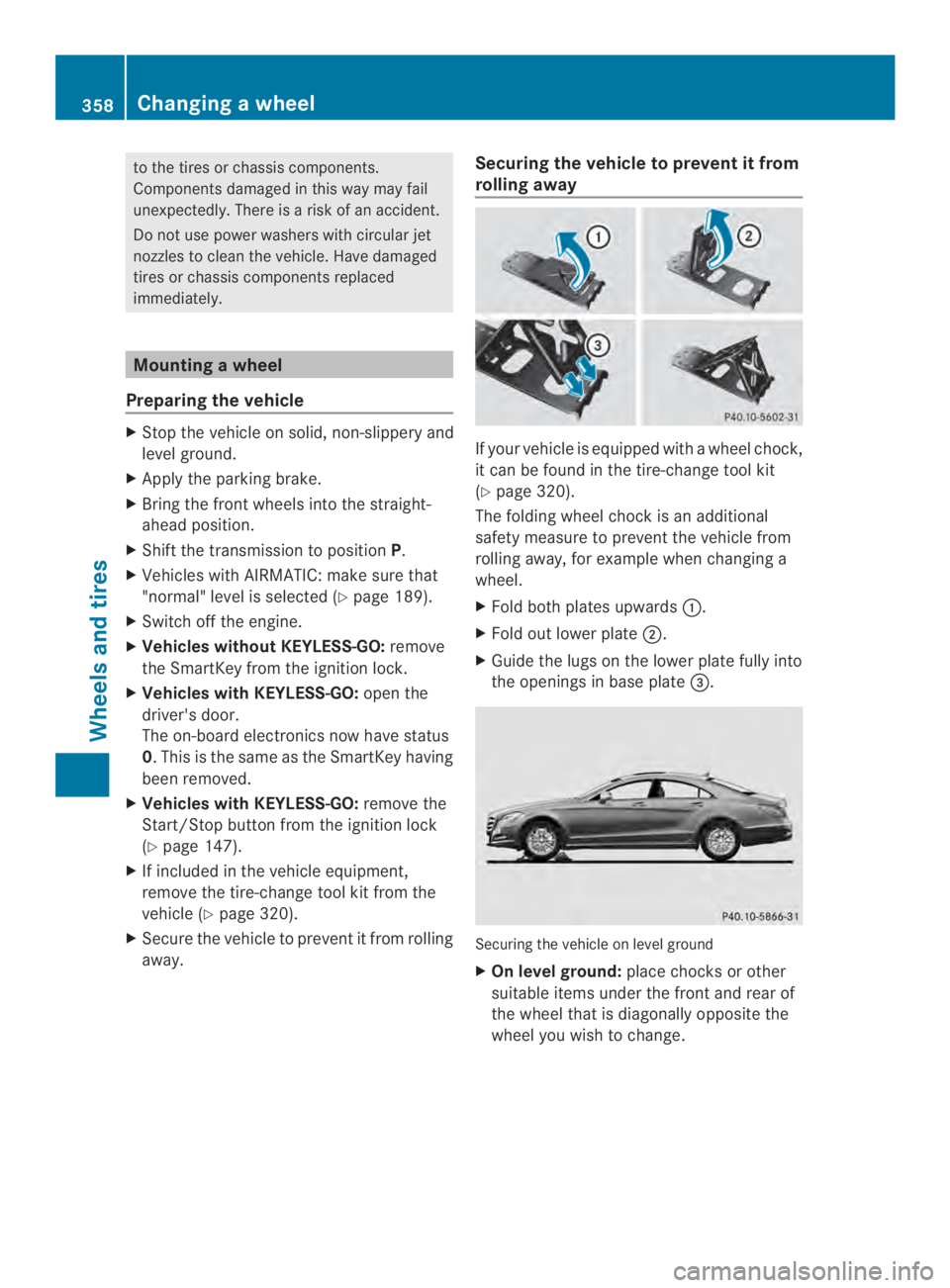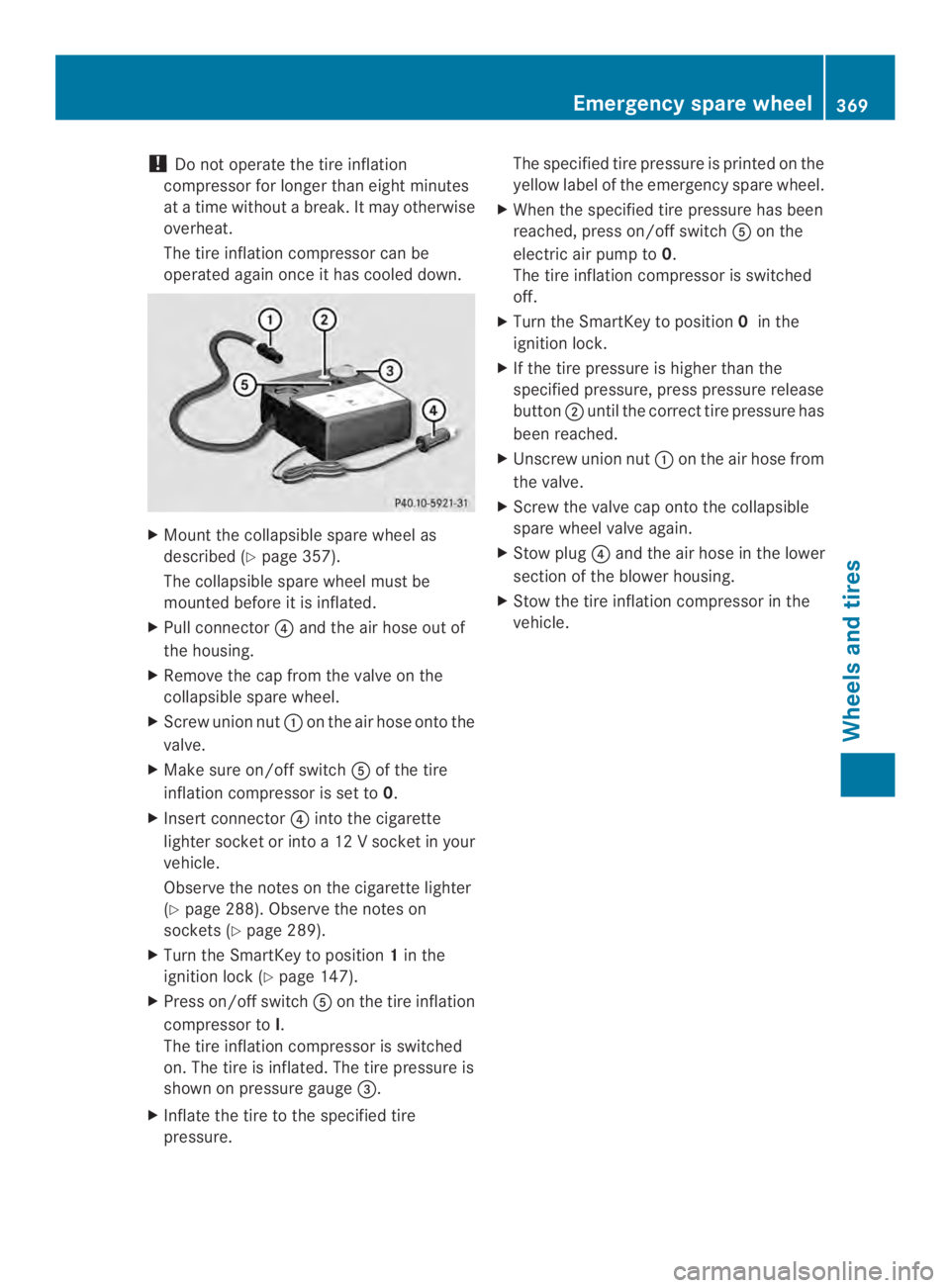Page 347 of 382

one or more tires has dropped suddenly
and the tires must be checked.
Observe the instructions and safety notes in
the display messages in the "Tires" section
(Ypage 258).
iIf the wheel positions on the vehicle are
rotated, the tire pressures may be
displayed for the wrong positions for a
short time. This is rectified afterafew
minutes of driving, and the tire pressures
are displayed for the correctpositions.
Restarting the tire pressuremonitor
When you restart the tire pressure monitor,
all existingwarning messages are deleted and
the warning lamps go out. The monitor uses
the currently set tire pressures as the
reference values for monitoring. In most
cases, the tire pressure monitor will
automatically detect the new reference
values after you have changed the tire
pressure. However, you can also define
reference values manually as described here.
The tire pressure monitor then monitors the
new tire pressure values.
XSet the tire pressure to the value
recommended for the corresponding
driving situation on the Tire and Loading
Information placard on the B-pillar on the
driver's side (Ypage 338).
Additional tire pressure values for different
loads can also be found on the tire pressure
table on the inside of the fuel filler flap
(Ypage 338).
XMake sure that the tire pressure is correct
on all four wheels.
XMake sure that the SmartKey is in position
2in the ignition lock.
XPress the�\nor��button on the
steeringwheel to select theServ.menu.
XPress the��or��button to select
Tire Pressure.
XPress the��button.
The multifunction display shows the
current tire pressure for each tire or the
Tire pressures will be displayed
after drivingafew minutes
message.
XPress the��button.
The multifunction display shows theUse
CurrentPressuresasNewReference
Valuesmessage.
If you wish to confirm the restart:
XPress the��button.
TheTire Press. Monitor Restarted
message appears in the multifunction
display.
After driving forafew minutes, the system
checkswhether the current tire pressures
are within the specified range. The new tire
pressures are then accepted as reference
values and monitored.
If you wish to cancel the restart:
XPress the��button.
The tire pressure values stored at the last
restart will continue to be monitored.
Loading the vehicle
Instruction labels for tires and loads
GWARNING
Overloaded tires can overheat, causing a
blowout. Overloaded tires can also impair the
steering and driving characteristics and lead
to brake failure. There isarisk of accident.
Observe the load rating of the tires. The load
rating must be at least half of the GAWR of
your vehicle. Never overload the tires by
exceeding the maximum load.
Two instruction labels on your vehicle show
the maximum possible load.
(1) The Tire and Loading Information placard
is on the B-pillar on the driver's side. The
Tire and Loading Information placard
shows the maximum permissible number
of occupantsand the maximum
permissible vehicle load. It also contains
Loading the vehicle345
Wheels and tires
Z
Page 360 of 382

to the tiresorchassiscomponents.
Components damagedinthiswaymayfail
unexpectedly.There isarisk of an accident.
Do not use power washers with circular jet
nozzles to clean the vehicle. Have damaged
tires or chassis components replaced
immediately.
Mountingawheel
Preparing the vehicle
XStop the vehicle on solid, non-slippery and
levelground.
XApply the parking brake.
XBring the front wheels into the straight-
ahead position.
XShift the transmission to positionP.
XVehicles with AIRMATIC:make sure that
"normal" levelisselected(Ypage 189).
XSwitch off theengine.
XVehicles without KEYLESS-GO:remove
theSmartKey from theignition lock.
XVehicles with KEYLESS-GO:open the
driver'sdoor.
The on-board electronics nowhave status
0.This is the same as the SmartKey having
been removed.
XVehicles with KEYLESS-GO:remove the
Start/Stop button from the ignition lock
(Ypage 147).
XIf included in the vehicle equipment,
remove the tire-change tool kit from the
vehicle (Ypage 320).
XSecure the vehicle to prevent it from rolling
away.
Securing the vehicle to prevent it from
rolling away
If your vehicle is equipped withawheel chock,
it can be found in the tire-change tool kit
(Ypage 320).
The folding wheel chock is an additional
safety measure to prevent the vehicle from
rolling away,for example when changing a
wheel.
XFold both plates upwards��.
XFold out lower plate��.
XGuidethe lugs on the lower plate fully into
the openings in base plate�$.
Securing the vehicle on level ground
XOn level ground:place chocksorother
suitable items under the front and rear of
the wheel that is diagonallyopposite the
wheel you wish to change.
358Changingawheel
Wheels and tires
Page 371 of 382

!Do not operate the tire inflation
compressor for longer than eight minutes
atatime withoutabreak. It may otherwise
overheat.
The tire inflation compressor can be
operated againonce it hascooleddown.
XMount the collapsiblespare wheelas
described (Ypage 357).
The collapsible spare wheel must be
mounted before it is inflated.
XPull connector�!and the air hose out of
the housing.
XRemove the cap from the valve on the
collapsible spare wheel.
XScrew union nut��on the air hose ontothe
valve.
XMake sure on/off switch��of the tire
inflation compressor is set to0.
XInsert connector�!intothe cigarette
lighter socket or intoa12Vsocket in your
vehicle.
Observe the notes on the cigarettelighter
(Ypage 288). Observe the notes on
sockets(Ypage 289).
XTurn the SmartKey to position1in the
ignition lock (Ypage 147).
XPress on/offswitch��on thetireinflation
compressor toI.
The tireinflationcompressor is switched
on. The tire is inflated. The tire pressure is
shown on pressure gauge�$.
XInflate the tire to the specified tire
pressure.
The specified tire pressure is printed on the
yellow label of the emergencyspare wheel.
XWhen the specified tire pressure has been
reached, press on/offswitch��on the
electric air pump to0.
The tireinflationcompressor is switched
off.
XTurn the SmartKey to position0in the
ignition lock.
XIf the tire pressure is higher than the
specified pressure, press pressure release
button��until the correcttire pressure has
been reached.
XUnscrew union nut��on the air hose from
the valve.
XScrew the valve cap ontothe collapsible
spare wheel valve again.
XStow plug�!and the air hose in the lower
section of the blower housing.
XStow the tire inflation compressor in the
vehicle.
Emergency sparewheel369
Wheels and tires
Z